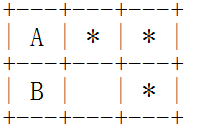卡片换位
你玩过华容道的游戏吗?
这是个类似的,但更简单的游戏。
看下面 3 x 2 的格子

在其中放5张牌,其中A代表关羽,B代表张飞,* 代表士兵。
还有一个格子是空着的。
你可以把一张牌移动到相邻的空格中去(对角不算相邻)。
游戏的目标是:关羽和张飞交换位置,其它的牌随便在哪里都可以。
输入格式:
输入两行6个字符表示当前的局面
输出格式:
一个整数,表示最少多少步,才能把AB换位(其它牌位置随意)
例如,输入:![]()
程序应该输出:
17
再例如,输入:![]()
程序应该输出:
12
资源约定:
峰值内存消耗 < 256M
CPU消耗 < 1000ms
请严格按要求输出,不要画蛇添足地打印类似:“请您输入...” 的多余内容。
所有代码放在同一个源文件中,调试通过后,拷贝提交该源码。
注意: main函数需要返回0
注意: 只使用ANSI C/ANSI C++ 标准,不要调用依赖于编译环境或操作系统的特殊函数。
注意: 所有依赖的函数必须明确地在源文件中 #include <xxx>, 不能通过工程设置而省略常用头文件。
提交时,注意选择所期望的编译器类型。
解题过程:
这道题一开始用bfs的时候发现结果怎么也不对,找了很久发现自己写的是其他字符位置不变,只是A和B互换位置为bfs的返回条件。
之后看了一下题,发现A和B互换位置即可,其他字符的位置随便怎么样都行。。 所以以后做题的时候一定要认真审题,不要急躁。
思路:用一个string保存每一个局面的状态,图中的数字表示string的下标i,当i-1,i+1,i-3,i+3分别表示向左,向右,向上,向下走。使用set对该局面(string)进行判重。
但是注意到用如下的图有限制,比如3-1 = 2,但是3和2并不相邻。

所以将每一个局面的状态的保存修改为如下string,string的下标3不使用(代码中将其赋予了#),此时i-1,i+1,i-4,i+4分别表示向左,向右,向上,向下走,这样就消除了边界的影响。

1 #include<iostream> 2 #include<string> 3 #include<queue> 4 #include<set> 5 #include<cstring> 6 #include<cmath> 7 #include<algorithm> 8 #include<stdio.h> 9 10 using namespace std; 11 12 int dx[4] = {1,-1,4,-4}; 13 14 string start_str; 15 int orig_posA; 16 int orig_posB; 17 18 struct node 19 { 20 int x; // 空格字符所在的下标 21 string str; 22 int step; 23 }; 24 25 void bfs(node nod) 26 { 27 queue<node> Q; 28 Q.push(nod); 29 set<string> sset; 30 sset.insert(nod.str); 31 32 node t, p; 33 while(!Q.empty()) 34 { 35 t = Q.front(); 36 Q.pop(); 37 38 /* 一开始把判断条件错误地写成了 if(t.str == end_str), end_str表示把 39 初始字符串中A,B位置互换后的字符串, 但是这样也把其他字符的位置固定死了 */ 40 // 正解:A和B的位置与一开始的位置互换即可,其他字符的位置随意 41 if(t.str.find('B') == orig_posA && t.str.find('A') == orig_posB) 42 { 43 cout << t.step << endl; 44 return; 45 } 46 47 48 for(int i = 0; i < 4; ++i) 49 { 50 int xx = t.x + dx[i]; 51 if((xx >= 0 && xx <= 2) || (xx >= 4 && xx <= 6)) 52 { 53 string ss = t.str; 54 swap(ss[t.x], ss[xx]); 55 p.x = xx; 56 p.str = ss; 57 p.step = t.step + 1; 58 if(sset.count(p.str) == 0) 59 { 60 sset.insert(p.str); 61 Q.push(p); 62 } 63 64 } 65 } 66 } 67 68 } 69 70 int main() 71 { 72 string s1; 73 string s2; 74 getline(cin, s1); 75 getline(cin, s2); 76 77 // 下标3不使用,此处将其赋值为了# 78 start_str = s1 + '#' + s2; 79 80 int start_x = start_str.find(' '); 81 orig_posA = start_str.find('A'); 82 orig_posB = start_str.find('B'); 83 84 node nod; 85 nod.x = start_x; 86 nod.str = start_str; 87 nod.step = 0; 88 bfs(nod); 89 90 91 92 return 0; 93 }